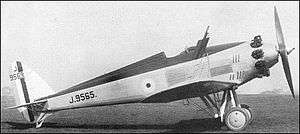Westland C.O.W. Gun Fighter
The Westland C.O.W. Gun Fighter was an attempt to produce a fighter aircraft armed with a heavy calibre gun. The Coventry Ordnance Works (COW) 37 mm automatic gun was used, which had been developed for this purpose some years earlier.
| C.O.W. Gun Fighter | |
|---|---|
 | |
| Role | Interceptor |
| Manufacturer | Westland Aircraft |
| First flight | December 1930 |
| Status | Prototype only |
| Number built | 1 |
| Developed from | Westland Interceptor |
Design and development
The design was in response to Air Ministry specification F.29/27. The design was an open cockpit single engined metal monoplane with fabric covering. The aircraft design had already been submitted for specification F.20/27 as the Westland Interceptor but had lost out to the Gloster Gauntlet. The gun was in the fuselage and fired up at an angle, in order to attack bombers from below. The plane first flew at the end of 1930 but the trials did not give satisfactory results to continue with the idea.
The COW gun had been developed by 1918 for use in aircraft and had been trialled on the Airco DH.4.
Specifications (C.O.W. Gun Fighter)
Data from Westland Aircraft since 1915 [1]
General characteristics
- Crew: 1
- Length: 29 ft 10 in (9.09 m)
- Wingspan: 40 ft 10 in (12.45 m)
- Height: 10 ft 7 in (3.23 m)
- Wing area: 223 sq ft (20.7 m2)
- Airfoil: RAF 34 [2]
- Empty weight: 2,615 lb (1,186 kg)
- Gross weight: 3,885 lb (1,762 kg)
- Powerplant: 1 × Bristol Mercury IIIA 9-cylinder air-cooled radial piston engine, 485 hp (362 kW)
- Propellers: 2-bladed fixed-pitch propeller
Performance
- Maximum speed: 185 mph (298 km/h, 161 kn) at 13,000 ft (3,962 m)
- Service ceiling: 27,900 ft (8,500 m) [3]
- Absolute ceiling: 29,400 ft (8,961 m)
- Time to altitude: 10,000 ft (3,048 m) in 7 minutes
- Wing loading: 17.4 lb/sq ft (85 kg/m2)
- Power/mass: 0.12 hp/lb (0.20 kW/kg)
Armament
- Guns: One fixed upward firing 1½ lb (37 mm) COW 37 mm gun with 39 rounds
See also
Related development
Aircraft of comparable role, configuration and era
References
- James 1991, pp.188–189.
- James p.186.
- Mason 1992, p.232.
- James, Derek N. Westland Aircraft since 1915. London: Putnam, 1991. ISBN 0-85177-847-X.
- Mason, Francis K. The British Fighter since 1912. Annapolis, Maryland: Naval Institute Press, 1992. ISBN 1-55750-082-7.
External links
- Westland COW Gun Fighter – British Aircraft Directory
- Westland history Accessed 1 Feb 2007
- http://users.skynet.be/Emmanuel.Gustin/history/NoAllowance.html Accessed 1 Feb 2007